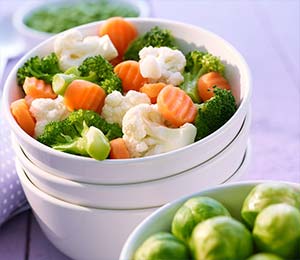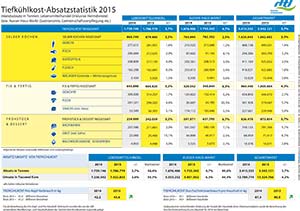The frozen food market in Germany continues to grow, as sales volume increased by 3.7% to 3,542 million metric tons and value advanced by 4.2% to EUR 13,235 billion in 2015. Per capita consumption rose by 1.4 kilos to 43.6 kg, while households on average consumed 90 kg, up from 87.3 in 2014, according to figures posted by the Deutsches Tiefkühlinstitut (DTI, the German Frozen Food Institute).
 The Berlin-based trade association, which is celebating its 60th anniversary this year, is pleased with the results when considering that the domestic food industry as a whole experienced a sales decline of 5.7% in 2015 .
The Berlin-based trade association, which is celebating its 60th anniversary this year, is pleased with the results when considering that the domestic food industry as a whole experienced a sales decline of 5.7% in 2015 .
 The frozen retail segment, including home delivery services, generated a growth rate of 2.7% on volume of 1,787 million tons. Sales value rose 2.6% to EUR 7.423 billion. Decisive for the upswing was the combination of “a high level of innovation, the strong presence of leading brands, and the increasingly diverse and high quality services in all product groups – from entry to premium levels,” according to the DTI.
The frozen retail segment, including home delivery services, generated a growth rate of 2.7% on volume of 1,787 million tons. Sales value rose 2.6% to EUR 7.423 billion. Decisive for the upswing was the combination of “a high level of innovation, the strong presence of leading brands, and the increasingly diverse and high quality services in all product groups – from entry to premium levels,” according to the DTI.
 Results were also positive in the foodservice and catering market segment, as professional chefs and cooks increasingly appreciate the convenience, reliability and quality of value-added frozen components, side dishes, meals and desserts. Volume climbed by 4.7% to 1,755 million tons, while sales value increased by 6.3% to EUR 5.902 billion.
Results were also positive in the foodservice and catering market segment, as professional chefs and cooks increasingly appreciate the convenience, reliability and quality of value-added frozen components, side dishes, meals and desserts. Volume climbed by 4.7% to 1,755 million tons, while sales value increased by 6.3% to EUR 5.902 billion.
Combined totals for all product categories across the board increased, with frozen fruits and juices logging the biggest percentage gain. The 2015 statistics are listed below:
- Vegetables, 495,031 tons, +1.4%
- Fish and Seafood, 303,790 tons, +3.2%
- Potato Products, 425,652 tons, +3.5%
- Meat Products, 422,685 tons, +1.6%
- Side Dishes, 15,444 tons, +2.8%
- Ready Meals, 446,672 tons, +2.7%
- Pizza, 319,047 tons, +5.7%
- Snacks (including cheese), 239,946 tons, +5.4%
- Baked Goods (including cakes and pies), 791,766 tons, +5.7%
- Fruits and Juices, 71,417 tons, +6.7%
- Dairy Products/Desserts, 10,671 tons, +2.8%






